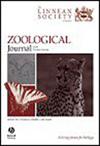The first pachycephalosaurid from the Late Cretaceous Two Medicine Formation: effects of the Western Interior Seaway on North American pachycephalosaurid evolution
IF 2.8
2区 生物学
Q1 ZOOLOGY
引用次数: 0
Abstract
During the latest Cretaceous, western North America experienced several regressive and transgressive cycles of the Western Interior Seaway (WIS). Closely related, time-successive taxa of tyrannosaurids, ceratopsids, hadrosaurids, and pachycephalosaurids have been proposed to have evolved via anagenesis driven by habitat area fluctuations related to sea level change. Previous examinations into these anagenetic hypotheses have resulted in equivocal results. However, evolution related to this WIS hypothesis has yet to be tested for Pachycephalosauria. Originally, it was hypothesized that an undescribed taxon from the Two Medicine Formation constituted an anagenetic intermediate between the Campanian Stegoceras validum and the Maastrichtian Pachycephalosaurus wyomingensis. Here we describe this Two Medicine Formation pachycephalosaurid and test the proposed anagenetic lineage. This taxon is the first pachycephalosaurid from the Two Medicine Formation, and the massive frontoparietal dome indicates that it was the third largest North American pachycephalosaurid. Phylogenetic analyses recover this new taxon distant from both Stegoceras and Pachycephalosaurus; thus, refuting the hypothesis that this taxon constitutes any part of an ancestor–descent series between Stegoceras and Pachycephalosaurus. However, the new taxon not only increases understanding of pachycephalosaurid morphology and diversity, but shows that this clade contained relatively large body-sized taxa as early as the Middle Campanian.晚白垩世两药组首头肿头龙:西部内陆航道对北美肿头龙进化的影响
在晚白垩纪,北美西部经历了几次西部内陆海道(WIS)的回退和海侵旋回。暴龙类、角鼻龙类、鸭嘴龙类和厚头龙类是密切相关的、时间连续的分类群,它们是由与海平面变化有关的栖息地面积波动驱动的再生进化而来的。先前对这些遗传假说的研究得出了模棱两可的结果。然而,与WIS假说相关的进化尚未在肿头龙身上得到验证。最初,人们假设来自“双药组”的一个未描述的分类群构成了坎帕尼亚的validum剑龙和马斯特里希特的wyomingensis厚头龙之间的一个杂交中间物种。在这里,我们描述了这两种药形成厚头龙和测试提出的遗传谱系。这个分类群是来自双药组的第一个厚头龙,巨大的额顶圆顶表明它是北美第三大的厚头龙。系统发育分析恢复了这一新分类群与剑角龙和肿头龙的距离;因此,驳斥了这个分类群构成剑角龙和厚头龙之间祖先-后裔系列的任何一部分的假设。然而,这一新分类群不仅增加了对厚头龙类形态和多样性的认识,而且表明该分支早在中坎帕纪就包含了相对较大的体型分类群。
本文章由计算机程序翻译,如有差异,请以英文原文为准。
求助全文
约1分钟内获得全文
求助全文
来源期刊
CiteScore
6.50
自引率
10.70%
发文量
116
审稿时长
6-12 weeks
期刊介绍:
The Zoological Journal of the Linnean Society publishes papers on systematic and evolutionary zoology and comparative, functional and other studies where relevant to these areas. Studies of extinct as well as living animals are included. Reviews are also published; these may be invited by the Editorial Board, but uninvited reviews may also be considered. The Zoological Journal also has a wide circulation amongst zoologists and although narrowly specialized papers are not excluded, potential authors should bear that readership in mind.

 求助内容:
求助内容: 应助结果提醒方式:
应助结果提醒方式:


